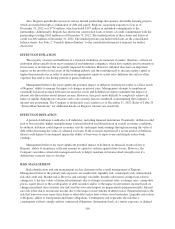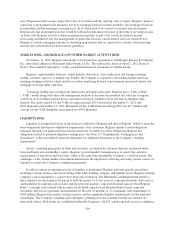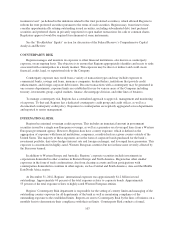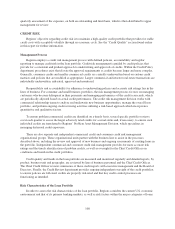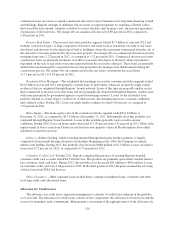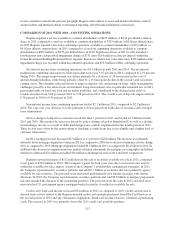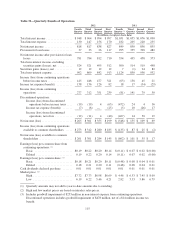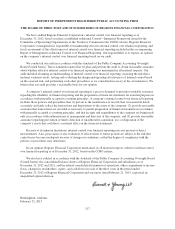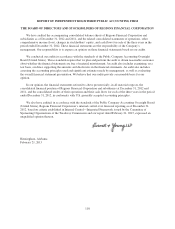Regions Bank 2012 Annual Report Download - page 125
Download and view the complete annual report
Please find page 125 of the 2012 Regions Bank annual report below. You can navigate through the pages in the report by either clicking on the pages listed below, or by using the keyword search tool below to find specific information within the annual report.Economic Environment in Regions’ Banking Markets
One of the primary factors influencing the credit performance of Regions’ loan portfolio is the overall
economic environment in the U.S. and the primary markets in which it operates. The “Great Recession” that
began in December 2007 and ended in June 2009 took a severe toll on the U.S. economy. However, by year-end
2012 many of the economic headwinds that had restrained the economy had diminished. In particular, the
housing market is recovering, consumers have reduced their leverage, and business and consumer confidence has
improved.
Considerable improvement is needed before the economy can be considered to have fully healed from the
Great Recession. The housing recovery comes from a low base and permits, starts, and sales will be well short of
levels that could be considered “normal” for some time to come. While having fallen to 7.8 percent by year-end
2012, the unemployment rate remains well above a level that could be considered consistent with full
employment, and at least some of the decline in the unemployment rate to date has come as a result of a lower
labor force participation rate. With what remains a high degree of labor market under utilization, wage and salary
growth remains weak and uneven which, in turn, is reflected in a slow rate of growth in disposable personal
income, particularly when adjusted for inflation.
It is expected that the private sector of the U.S. economy will continue to strengthen throughout 2013. The
housing market recovery should continue, household balance sheets should continue to improve, and corporate
balance sheets are healthy. What will remain is a highly stimulative monetary policy, with the Federal Open
Market Committee (“FOMC”) actively engaged in holding down long-term interest rates that will be supportive
of the recovery in the broader economy. There are, however, some economic risks that could adversely impact
Regions’ operating environment over the near term.
As 2013 begins, federal fiscal policy is exerting a drag on the economy with the potential for this drag to
intensify. Higher payroll tax rates impact all workers with wage and salary earnings, even those who may not pay
personal income taxes. This is expected to have a material adverse impact on growth in consumer spending
during the first quarter of 2013. Moreover, with the sequestration spending cuts set to take effect March 1, 2013,
the economy is facing roughly $100 billion of cutbacks in federal government expenditures on an annual basis
for the next ten years, which would act as an additional drag on the broader economy. Additionally, while the
risks of a catastrophic outcome in the Euro Zone have been diminished by an aggressive policy stance by the
European Central Bank, the underlying structural constraints that act as a significant drag on growth in many
Euro Zone nations have yet to be addressed, meaning that Europe cannot be ruled out as a downside risk.
In summation, after the Gross Domestic Product (“GDP”) grew at 2.2 percent in 2012, the U.S. economy’s
GDP is expected to grow approximately 2.0 percent in 2013, with slower growth over the first half of the year
and faster growth over the second half of the year. Should the recovery broaden and strengthen over the second
half of 2013, as is anticipated, economic growth would be stronger in 2014.
Portfolio Characteristics
Regions has a diversified loan portfolio, in terms of product type, collateral and geography. At
December 31, 2012, commercial loans represented 50 percent of total loans, net of unearned income, investor
real estate loans represented 10 percent, residential first mortgage loans totaled 18 percent and other consumer
loans, largely home equity lending, comprised the remaining 22 percent. Following is a discussion of risk
characteristics of each loan type.
Commercial—The commercial loan portfolio segment totaled $37.1 billion at year-end 2012 and primarily
consists of loans to small and mid-sized commercial and large corporate customers with business operations in
Regions’ geographic footprint. Loans in this portfolio are generally underwritten individually and are usually
secured with the assets of the company and/or the personal guarantee of the business owners. Also considered as
109



